Article and all photos by Joe Mock, BaseballParks.com
All rights reserved
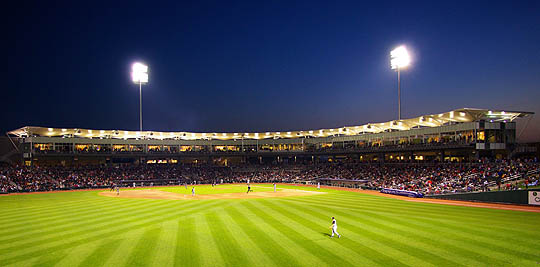 |
There are lots of ways you can use the word “natural.” Like “There’s nothing artificial in this. It’s all natural.” Or “This setting really shows the natural beauty of the area.” Or “The official nickname of the state of Arkansas is ‘The natural state.'” Or “That baseball player has great skills. He’s a natural.”
| Ballpark Stats |
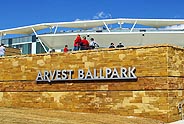 |
| Winner of the 2008 BASEBALLPARKS.COM Ballpark of the Year Read the press announcement here |
| Team: The Texas League’s Northwest Arkansas Naturals |
| First game: April 10, 2008, a 7-1 win by San Antonio over Northwest Arkansas |
| Capacity: 6,800 seats including the suites and picnic areas; 7,500 including berms |
| Architect: HOK Sport |
| Price: $50 million for the entire project; $41 million for construction of the park and lots |
| Home dugout: First base side |
| Field points: East by northeast |
| Playing surface: Patriot Bermuda grass, overseeded with rye |
| Betcha didn’t know: The stadium’s field lights don’t need to be on when the cleaning crew is cleaning the park |
Well, Arvest Ballpark, the home of the Northwest Arkansas Naturals baseball team, can lay claim to all of those meanings of “natural.” And then some. That’s why it is BASEBALLPARKS.COM’s Ballpark of the Year for 2008.
When sagging attendance and an aging ballpark (that has an unholy alliance of artificial turf in the infield and natural grass in the outfield) drove the Wichita Wranglers to look for a new home, the booming Northwest Arkansas market, one of the fastest growing metro areas in the U.S., was more than ready to welcome them. Specifically, the city of Springdale, tucked between the larger city of Fayetteville to the south and the smaller towns of Bentonville and Rogers to the north, had the leadership team to make a ballpark a reality.
Springdale’s longtime Mayor Jerre M. Van Hoose and the dynamic head of the Chamber of Commerce, Perry Webb, knew what it would take to bring the affiliated Minor Leagues to the area. Not only would you have to find a team willing to move, you’d also have to provide them with a better facility than what they’d be leaving behind. This took public acceptance and a top-flight architect to design it. The former came in the form of a referendum on July 11, 2006, where local voters approved — by the narrowest of margins — the continuation of a one-percent sales tax to fund the ballpark. The latter came from HOK, which utilized their talented Minor League Group to design a facility that fits in its environment beautifully.
That design showed special insight into building materials and construction techniques that are truly state-of-the-art in the area of conservation and the current buzz word of “sustainability.”
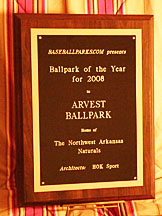 |
And there’s none of Wichita’s fake grass in the infield — or anywhere else — here. This ballpark is as natural as it gets … and beautifully so, I might add.
Before we dive into a closer look at the new showplace of Northwest Arkansas and highlight why it is our Ballpark of the Year, allow me to point out that Opening Day in Springdale proved something I’ve suggested a number of times — that God’s favorite sport is baseball. During the previous 24 hours, a line of killer storms with tornadoes and hail tore through that part of the country. All of the forecasters said that the storms were going to continue right through the day. The morning of the game, I didn’t think it was possible that the Opener would be played, much less that we’d actually have nice weather. However, by the time of the ribbon cutting ceremony that afternoon, the sun was out. It was a gorgeous evening, as befits an event as anticipated as this one. Thanks, God!
The Setting
To say that Springdale’s new park is situated in a pastoral setting is an enormous understatement. When you first approach the site of Arvest Ballpark on nothing but two-lane roads, you are stunned that rising from the surrounding cow pastures is a modern ballpark. How in the world did it end up here? Did someone make a mistake and send the bulldozers to the wrong spot?
Indeed, when 7,820 fans descended on the park on Opening Day, those two-lane roads were completely overwhelmed. Bumper-to-bumper traffic (matched only by the lines at the concession stands) stretched for miles.
 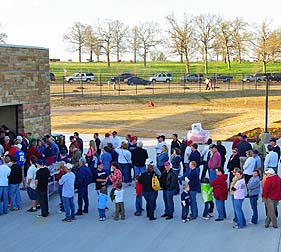 |
I spoke to Springdale Mayor Van Hoose about this. He explained that the owners of those cow pastures (like the one beyond right field in the photo on the left) are working with a developer on a “master plan that will bring development to the area surrounding the park.” I’ve read elsewhere that a large mall, an arena, a hotel and residential areas are all being contemplated for that acreage.
The Mayor added that, “We know we have a traffic problem right now, but we’re building a road that will run around the park and have an interchange with (Interstate) 540, so it will get better.”
So there are no restaurants, gas stations, hotels or stores adjacent to the ballpark at this point (although, to be fair, all of these are located just over a mile away at the intersection of I-540 and U.S. 412), but there will be. And the two-lane country roads will be augmented by a four-lane access highway soon. So while the site selection might seem questionable in the short run, as time goes by, I think the odds are very good that we’ll think it a stroke of genius.
The Exterior
I can make this short: the exterior of Arvest Ballpark is perfect.
Not since PNC Park in Pittsburgh and the Dell Diamond in Round Rock debuted with light-colored limestone as their principal building material has a new park burst on the scene with such a wonderfully different exterior. True, dark-red brick has been done to death and I think we’ll be happy to receive a respite from it on new parks for awhile, but the different approach here is phenomenal.
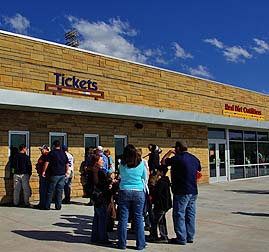 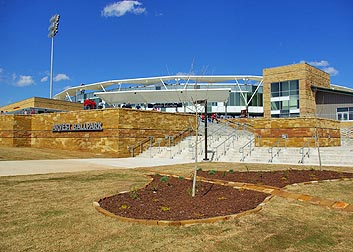 |
As the shots above show, this magical building material is natural stone, from local quarries no less. One reason it is so remarkable is because it’s so refreshing. The other, obviously, is that this gives the structure a very, well, natural look. With the team’s nickname being the Naturals, and with the official state nickname being “The Natural State,” it was the perfect choice.
“When we would be driving down here (to Springdale) from Kansas City, we kept noticing outcroppings of rock in the pasture lands,” Martin DiNitto, Associate Principal at HOK, told me. These outcroppings struck the designers as being very natural while also exhibiting undeniable attractiveness. “While we studied about eight different design approaches for this park, we kept coming back to the fact that there is a lot of ‘nature’ and scenic fields in this area. That led us to go with the natural look of the stone.”
The main entryway (above right) behind home plate is very well done. Because the 40-acre site has about a 30-foot slope from its northern edge (down the left-field line) to its southern boundary (behind first base), this permitted HOK to design a grand entry where steps lead you up to a plaza where the box office and entry gates are. This is also the same level as the concourse, so when you walk to your seats, you are walking down toward a playing field that is 17 feet below the concourse.
I like this arrangement because it takes advantage of the “lay of the land” at the site in a, well, natural way. There have been several parks in recent years that have tackled this in, to me, an unnatural way, having you walk up stairs to get an elevated concourse — needlessly. Also, the park is situated in the northeast corner of the 40 acres, close to the intersection of the east-west Watkins Avenue and the north-south 56th Street. Until the new access road is built, this is the way almost all fans will be approaching the park, so they’ll see the beautiful seating bowl from beyond center field as they are driving up to the park — and this is quite preferable to having your first view of the park being beyond a sea of parking spaces.
As Mayor Van Hoose put it when I asked him his favorite aspect of the park, “I love the way the architects fit the park into the land instead of trying to shape the land around the park.”
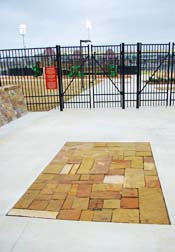 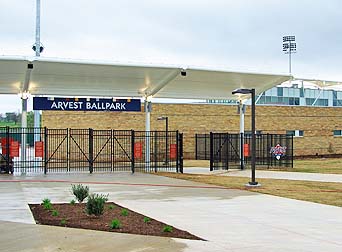 |
Where there isn’t natural stone surrounding the facility, you’ll find iron fencing (see above left) that permits fans standing on the outside — and those driving up to the park — to see clearly inside, all the way to the field. Try finding that at any Major League park! Not only does this add to the attractiveness of the scene from the outside, it also enhances the sense of “openness” on the inside … and as we’ll see, that’s one of the key components of the interior design.
Finally, the landscaping around the outside of the park is very well-thought-out. True, the plants are on the immature side now, and the lawns exhibit gaps between the pads of sod, but time will take care of this. The important part is that the initial design does indeed make sense. Further, special care was taken to select plants which are low-maintenance and which require less water. This emphasis on conservation and responsibility is also a major part of the park’s overall theme.
The Design
When you first take a good look at the interior of Arvest Ballpark, you might jump to the conclusion that its modern glass-and-steel look might clash with the “organic” look of all of that stone on the exterior, especially since the same stones were used on the field side of the outer buildings as on the parking-lot side.
In my opinion, it doesn’t clash. Here’s why: this facility is all about being natural and open, like the great outdoors … like the wonderful scenic beauty of this part of Arkansas. And, frankly, to be (and I’m getting so I don’t like this word) “green.”
Arvest Ballpark is essentially two separate structures: the outer buildings that contain the box office, souvenir shop, team offices, concession stands and restrooms; and the suites level, which is basically on stilts above the concourse. Except for two “bridges” that connect the suites level with the stairs in the outer buildings, these two structures don’t touch each other.
 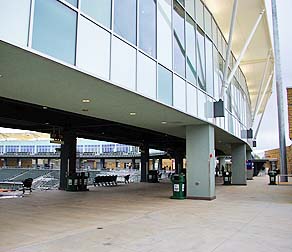 |
Not only that, each structure’s look is quite different than the other (see above left). The earthy stone outer building looks more traditional than the shiny, somewhat modern look of the glass upper structure. The reason I don’t think they clash is because they help achieve the overall theme of the ballpark: to reflect the natural beauty of the Northwest Arkansas environment. While the outer building resembles the pastures and rock outcroppings of the surrounding fields, the steely glass of the upper level reminds one of the sky, and the lovely white canopies on top evoke billowing clouds.
So, yes, I think it works. And when you boil it all down, it strikes me that the three keys to this park’s architecture are: the openness (like the great outdoors); its roof; and its environmental friendliness. These three areas are so well-thought-out that they work together as a cohesive whole.
Let’s look first at the openness. I’ve already mentioned that the field isn’t surrounded by buildings and walls. Instead, beyond the outfield concourse, and in the breaks between the buildings, are iron fences that let lots of light and air flow into the structure. They also allow fans on the outside to see clearly into the park. Further, Arvest Ballpark takes the already wildly popular notion of an “open concourse” and takes it to the extreme. These are incredibly open concourses, in that not only can you see clearly to the field of play while walking to and from the concession stands, the concourse is “open” on both sides (see above right), not just the field side like at most baseball stadiums. It’s nice being able to look up at the sky while in line at the concession stands — even the ones behind the infield. The size of the “footprint” of the park also allows for extra grassy areas beyond the berms in the outfield for kids to run around and burn off excess energy — another plus in the “openness” column.
But even with all of its wide-open spaces, that doesn’t mean that the fans are a long distance from the action. “It is an open ballpark, but it’s still intimate,” said Steven Davis, the team’s play-by-play broadcaster. “The seats are close, the suites are close, the press box is close. Nothing feels like it’s removed from the field.”
I’ve always maintained that ballparks without some kind of roof or overhang — even if it’s a trellised covering like at most of the spring-training parks in Arizona — look unfinished. That’s why I’m not crazy about so many Western parks because they totally lack any sort of covering over any part of the stands. The canopies here at Arvest are indeed beautiful, and really do make you think of the irregular shape of clouds. Nelson Wolff Stadium in San Antonio has long been one of my favorites because of its curving roof over its upper deck, and especially because of the way carefully positioned lights illuminate the underside of those panels at night. Borrowing a page from HOK’s own book (they also designed Wolff), the canopies in Springdale also use lighting underneath them to make them even more beautiful at night. These canopies might be my very favorite design element at Arvest Ballpark.
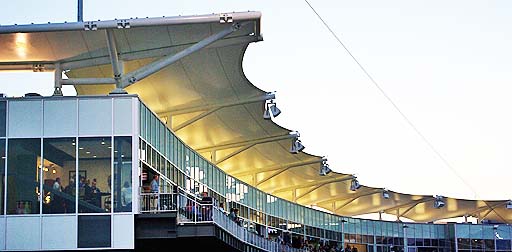 |
And finally, this park is incredibly environmentally friendly, and it shows. Much of the “green-ness” of another HOK park that debuted in 2008, Nationals Park in D.C., isn’t at all obvious to the average fan (e.g., the environmental clean-up on the site before construction began, the filtering of waste water, the amount of recycled material in the construction). At Arvest Ballpark, the “green” elements are quite evident: glazing on the suite-level windows to make them tremendously more energy efficient; the canopies and position of the upper level to provide immense shade on the fans in the stands and the concrete of the concourse; the way the concourse is open on both sides to promote air flow; drought-resistant landscaping; etc.
However, Arvest Ballpark probably won’t achieve the LEED (Leadership in Energy and Environmental Design) Certification like its cousin ballpark in Washington has. “You have to start the project with that as your goal,” HOK’s DiNitto told me. “Plus it costs a lot more to do all of the things necessary to obtain the certification. However, we were able to achieve a high level of sustainability through the use of natural building materials, low-flow toilets, energy-efficient lighting and the like.”
In fact, the whole subject of “light” at Arvest is one that could fill an article by itself. Not only do the fixtures in suites, restrooms and offices use less wattage, there are sensors that turn off the lights when the spaces aren’t occupied. Also, there are fixtures in places you wouldn’t ordinarily have them so that they can be utilized when crews are cleaning the stadium after a game — meaning the bright field lights on the light towers can be turned off. And don’t forget that shadows are critically important to keep the customers and the concrete under them cooler.